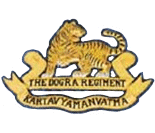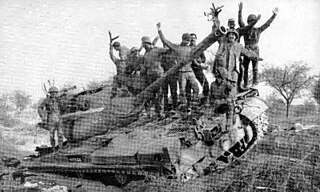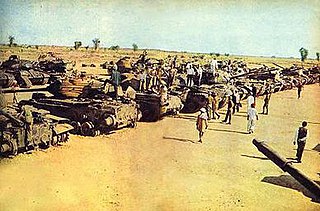
The 4th Indian Infantry Division, also known as the Red Eagle Division, is an infantry division of the Indian Army. This division of the British Indian Army was formed in Egypt in 1939 during the Second World War. During the Second World War, it took part in campaigns in East Africa, Syria, North Africa and Italy. Post independence, the division is part of the I Corps and headquartered at Prayagraj.
The 1st Armoured Division is an armoured division of the Indian Army, headquartered at Patiala, Punjab. It is part of II Corps of the Indian Army's Western Command.

The Dogra Regiment is an infantry regiment of the Indian Army. The regiment traces its roots directly from the 17th Dogra Regiment of the British Indian Army. When transferred to the Indian Army like its sister regiments, the numeral prefix was removed. Dogra Regiment Units Maximum filled with Rajputs And Sikh. Units of the Dogra Regiment have fought in all conflicts that independent India has been engaged in, making it one of the most prestigious and most decorated regiments of the Indian Army.

The Battle of Basantar, also known as the Battle of Shakargarh or Battle of Barapind, was one of the vital battles fought as part of the Indo-Pakistani War of 1971 in the western sector of India. The Indian troops won a hard-fought battle that secured this area in the Punjab/Jammu sector. The name Battle of Basantar actually encompasses the entire gamut of battles and skirmishes fought in the Shakargarh sector.

The Battle of Asal Uttar was one of the largest tank battles fought during the Indo-Pakistani War of 1965. It was fought from 8 to 10 September 1965, when the Pakistan Army thrust its tanks and infantry into Indian territory, capturing the Indian town of Khemkaran 5 km from the International Border. The Indian troops retaliated, and after three days of bitter fighting, the battle ended with the Pakistani forces being repulsed near Asal Uttar. Factors that contributed to this were the fierce fight put up by the Indian Army, conditions of the plains, better Indian tactics, and a successful Indian strategy.
The 15th Indian Division was an infantry division of the British Indian Army that saw active service in the First World War. It served in the Mesopotamian Campaign on the Euphrates Front throughout its existence. It did not serve in the Second World War, but was reformed at Dehradun in 1964 as part of the post-independence Indian Army.

Naik Jadunath Singh was an Indian soldier who was posthumously awarded the Param Vir Chakra, India's highest military decoration, for his actions in an engagement during the Indo-Pakistani War of 1947–1948.

Brigadier Narinder Singh Sandhu MVC was an Indian Army officer who was awarded the Maha Vir Chakra (MVC), the second-highest Indian military decoration, for gallantry, leadership and devotion to duty during the Indo-Pakistan War of 1971. Sandhu was commissioned into the Indian Army Armoured Corps in 1953, and participated in the Battle of Asal Uttar during the Indo-Pakistani War of 1965, and was mentioned in dispatches. He transferred to the Dogra Regiment in 1970, and it was for his performance as commanding officer of the 10th Battalion, Dogra Regiment during an assault on a fortified Pakistan Army position that he was awarded the MVC. He retired as a brigadier and was active in veterans' and gallantry award recipients' matters until his death of colorectal cancer in 2018.
20 SATA Regiment, nicknamed the Alma Mater of Locators and The Originals, is a Surveillance and Target Acquisition (SATA) artillery regiment, which is part of the Regiment of Artillery of the Indian Army.
17 Parachute Field Regiment is part of the Regiment of Artillery of the Indian Army.
861 Missile Regiment is a missile equipped regiment which is part of the Regiment of Artillery of the Indian Army.
2 Medium Regiment is part of the Regiment of Artillery of the Indian Army.
91 Field Regiment (Asal Uttar) is part of the Regiment of Artillery of the Indian Army.
29 Air Defence Regiment (Samba) is an Air Defence regiment of the Indian Army.
52 Medium Regiment (Sanjoi Mirpur) is part of the Regiment of Artillery of the Indian Army.
32 Field Regiment is part of the Regiment of Artillery of the Indian Army.
1 Field Regiment (Meiktila) is part of the Regiment of Artillery of the Indian Army. It is the first field artillery unit with Indian officers.
60 Medium Regiment is part of the Regiment of Artillery of the Indian Army.
13 Field Regiment (Chushul and Gadra City) is part of the Regiment of Artillery of the Indian Army, and has the distinction of having two post-independence honour titles.
42 Medium Regiment (Dera Baba Nanak) is part of the Regiment of Artillery of the Indian Army.





